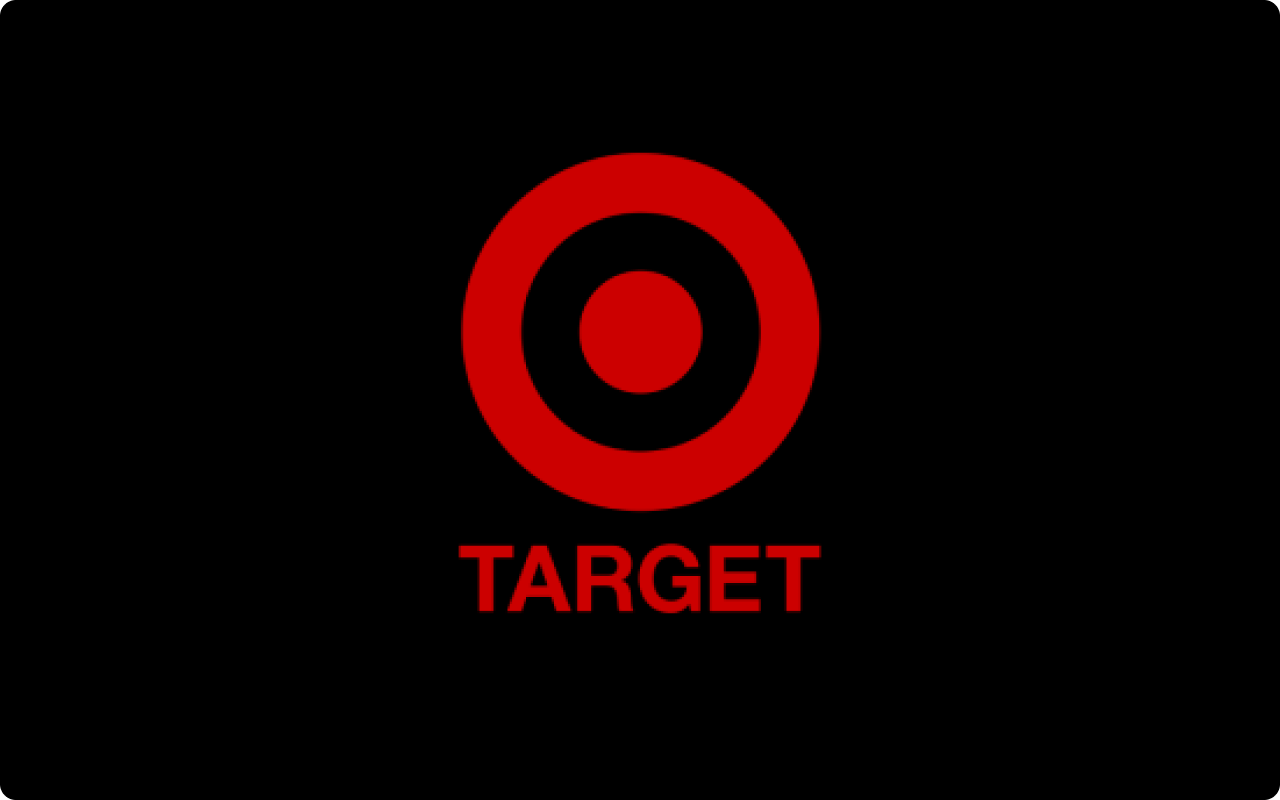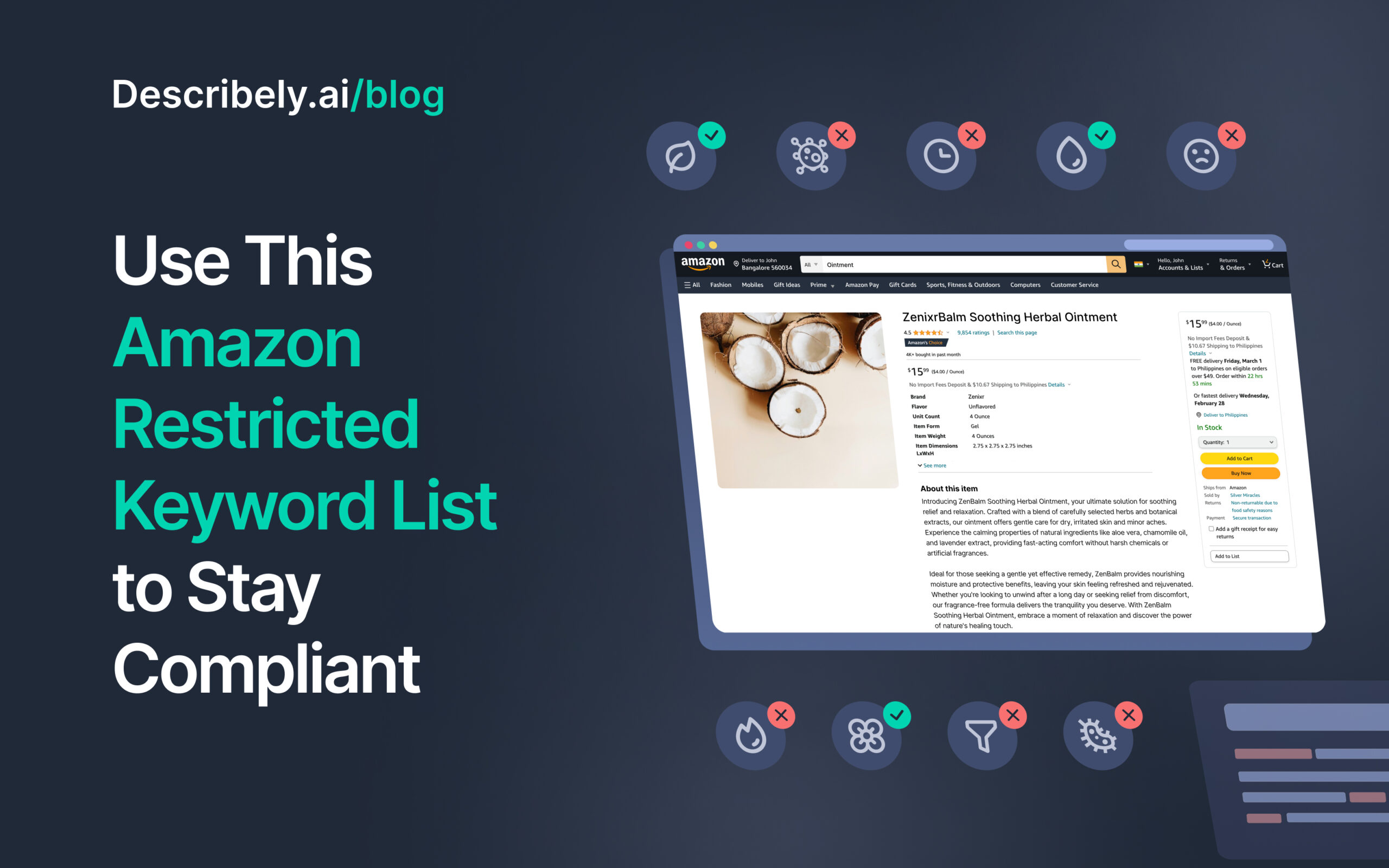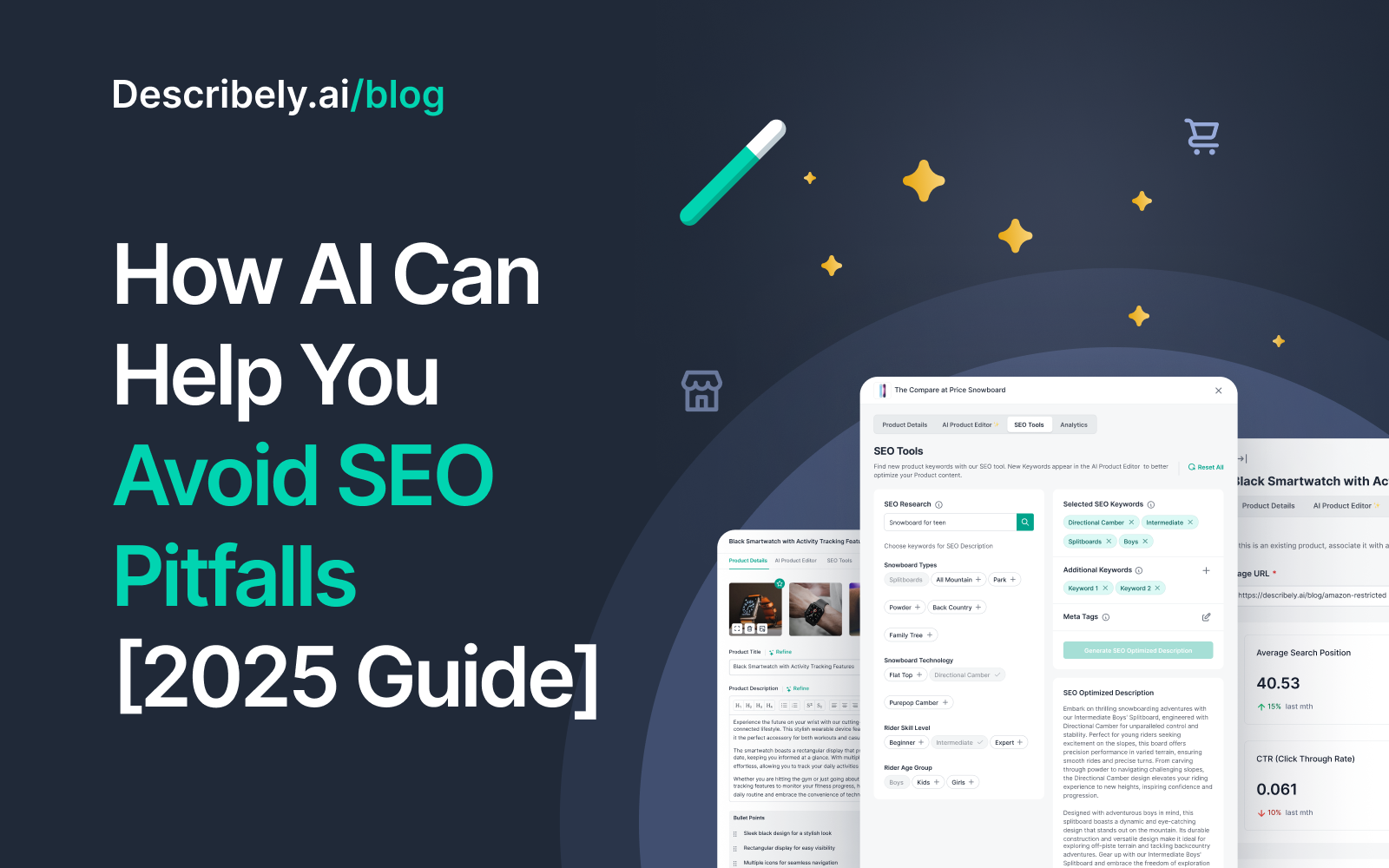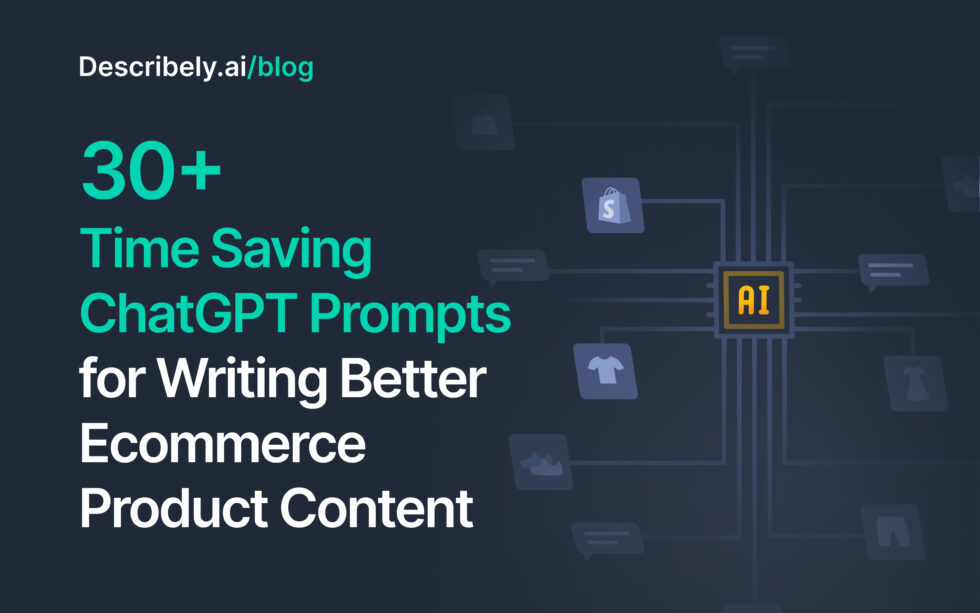
Resource: 30+ Time Saving ChatGPT Prompts for Writing Better Ecommerce Product Content
When you have an endless list of eCommerce product content to manage, ChatGPT prompts can be hit-or-miss.
Especially if you’re an online retailer, dropshipper, or if you manage an eCommerce store with hundreds or thousands of products to generate copy for.
Either you blaze through your work cranking out product copy using AI, or waste hours testing and rewriting the ChatGPT generated prompt.
If you want to save yourself all this trial and error, you’ve come to the right place.
Below you’ll find over 30 ChatGPT prompts to help you save time creating unique, and on-brand eCommerce product copy — from product descriptions and titles, to meta descriptions and tags.
Note: We know that these prompts work not only from testing but because Describely.ai makes a great benchmark as an AI tool specialized in product content. This makes it easy to verify whether or not these prompts follow the eCommerce best practices.
P.S. If you’re struggling to get ChatGPT to work well for your eCommerce product descriptions? Check out how it compares to Describely in this post.
Can ChatGPT Really Write My Ecommerce Product Copy?
If you’ve tried writing product copy with ChatGPT, chances are you didn’t get it right the first few times. That’s because, among other reasons, ChatGPT isn’t designed around ecommerce, especially for large ecommerce retailers. The broader the tool, the more work there is to filter out generic responses.
If you use ChatGPT the right way (with prompts) then yes — it’s especially efficient when you’re either starting from scratch or rewriting outdated listings.
But here’s the big question —Can ChatGPT write winning product copy? Probably not, at least not without the prompts we’re going to give you in this post.
Without the best product description generator, the higher your quality expectations, the more you need to consider for your prompts, such as:
- Repetitive language
- Competitor differentiation
- Consistency across other products
- Adapting to your brand voice
- Up-to-date keywords included naturally
The problem is, creating effective prompts isn’t straightforward.
ChatGPT sometimes ignores sentences based on their placement, and the same prompt can give inconsistent answers for different products. It can take several attempts to refine prompts before you can repeat it for dozens of other products.
That’s why we already tested these prompts for you— and why ecommerce marketers often use Describely instead.
If your short on time, we put all of the prompts into a PDF guide for you. Click here to grab a PDF version of the 30+ Prompts for Better Ecommerce Product Content

Contents:
- ChatGPT Prompts for Ecommerce Product Descriptions
- ChatGPT Prompts for Titles
- ChatGPT Prompts for Meta Descriptions
- ChatGPT Prompts for Tags
Prompts for Writing Product Descriptions
If you’re launching dozens of products, you’re probably not always familiar with all of them, let alone inspired. This disconnection can lead you to write dull descriptions only based on features rather than benefits and stories. Even if you are passionate, when you write content at scale, your 10th description may not always be as brilliant as the first one.
What if you instead use the right ChatGPT prompts for product descriptions?
- You won’t have to learn every tone, buyer, and product
- You won’t lose quality with your AI generated content
- You will have more time to focus on other things
Once you have a great description you can leverage it to write better titles, meta-descriptions, and tags. All you need is a specific product name, your main selling point, and any of the 11 prompts below:
Prompt Title: Writing Product Descriptions That Include Certain Words
Prompt:
I need to write a product description for our [type of product] that not only informs and persuades but also includes these specific words or phrases: [List of Words]. Make sure the description is coherent and the words are naturally integrated.
Instructions:
To use this prompt, fill in the variables with the relevant information:
- [type of product]: Specify the kind of product you’re writing the description for, like a smartwatch, a handbag, or a kitchen gadget.
- [List of Words]: List the specific words or phrases that you want included in the product description. These could be SEO keywords or phrases that align with your brand voice.
Example:
A completed prompt might look like this: “I need to write a product description for our coffee maker that not only informs and persuades but also includes these specific words or phrases: energy-efficient, quick brew, stainless steel. Make sure the description is coherent and the words are naturally integrated.”
Why this prompt is effective:
This prompt helps you write product descriptions that not only serve their basic function but are also optimized for specific words or phrases you want to target. This could be super useful for SEO or to align with certain marketing strategies.
Prompt Title: Crafting Product Descriptions that Exclude Specific Words
Prompt:
I need a product description for our [type of product] that effectively describes its features and benefits but avoids using these specific words: [List of Excluded Words]. Make sure the description still communicates the essence of the product.
Instructions:
To use this prompt, plug in your details where the variables are:
- [type of product]: Let AI know what kind of product you’re trying to describe—could be anything from headphones to skincare products.
- [List of Excluded Words]: Throw in the words or phrases you don’t want in the description. Maybe they’re industry jargon or just don’t align with your brand.
Example:
For instance, a filled-out prompt might read: “I need a product description for our running shoes that effectively describes its features and benefits but avoids using these specific words: ergonomic, state-of-the-art, cutting-edge. Make sure the description still communicates the essence of the product.”
Why this prompt is effective:
This prompt is a handy tool for when you need to sidestep certain terms—whether you’re avoiding jargon, cliche terms, or anything else that doesn’t fit with your brand’s voice.
Prompt title: Boosting Sales with a Product Description That Motivates Customers to Make a Purchase
Prompt:
Write a compelling product description for our [type of product] that accentuates its primary features and benefits, persuading the customer to make a purchase.
Instructions:
To use this prompt, fill in the variables with the relevant information:
- [type of product]: Insert the specific product you’re detailing, e.g., smartwatch, eBook, cosmetic product.
- Key features and benefits: Outline the standout aspects of your product that you wish to emphasize.
Here’s a practical example:
Write a compelling product description for our smartwatch that accentuates its primary features and benefits, such as 24-hour heart rate monitoring and customizable watch faces.
Why this prompt is effective:
Implementing this prompt guarantees your product descriptions not only inform but also resonate with potential buyers, nudging them closer to a purchase decision.
Prompt Title: Elevate Your Product Copy by Writing Like an Expert Level Copywriter
Prompt:
I want to describe our [specific product] with the finesse of an expert copywriter. Please craft a product description that’s compelling, captivating, and showcases superior copywriting skills.
Instructions:
To use this prompt, fill in the variables with the relevant information:
- [specific product]: Input the exact product you’re spotlighting, such as ‘organic bamboo kitchenware’, ‘LED mood lighting’, or ‘vegan leather boots’.
Here’s a practical example:
I want to describe our organic bamboo kitchenware with the finesse of an expert copywriter. Please craft a product description that’s compelling, captivating, and showcases superior copywriting skills.
Why this prompt is effective:
Utilizing this prompt ensures your e-commerce product descriptions are not only informative but also compelling, evoking interest and driving potential sales.
Prompt Title: Crafting Product Content with The Right Tone: From Humor to Luxury
Prompt:
I need to describe our [specific product] by adopting a [chosen tone] tone. Draft a product description that aligns with this tone, making it resonate with our target audience.
Instructions:
To use this prompt, fill in the variables with the relevant information:
- [specific product]: Fill in with the particular product you’re highlighting, such as ‘handcrafted leather journal’, ‘next-gen gaming console’, or ‘natural face serum’.
- [chosen tone]: Specify the tone you’re aiming for, e.g., humorous, luxurious, casual, authoritative.
Here’s a practical example:
I need to describe our handcrafted leather journal by adopting a luxurious tone. Draft a product description that aligns with this tone, making it resonate with our target audience.
Why this prompt is effective:
By using this prompt, you’re ensuring that your product descriptions not only provide information but also evoke specific emotions or vibes, catering to your target market’s preferences.

Prompt Title: Creating Product Descriptions Within a Specific Word Range (Example:150-300 Words)
Prompt:
Craft a detailed description for our [specific product] that captures its essence and features, ensuring it falls within a 150-300 word range.
Instructions:
To use this prompt, fill in the variables with the relevant information:
- [specific product]: Replace with the actual product you’re detailing, such as ‘multi-functional smart blender’, ‘wool-blend winter coat’, or ‘ergonomic office chair’.
Here’s a practical example:
Craft a detailed description for our multi-functional smart blender that captures its essence and features, ensuring it falls within a 150-300 word range.
Why this prompt is effective:
Following this prompt helps you create product descriptions that are concise yet encompassing, delivering the necessary details without overwhelming potential buyers.
Prompt Title: Writing Keyword Rich Product Descriptions Optimized for Google and Amazon SEO
Prompt:
Draft a product description for our [specific product] that’s rich in keywords relevant to our niche. Ensure it’s optimized for both Google and Amazon’s search algorithms. Use the following keywords and weave them into the content naturally: [insert keywords].
Instructions:
To use this prompt, fill in the variables with the relevant information:
- [specific product]: Input the precise product you’re emphasizing, like ‘rechargeable outdoor lantern’, ‘quilted backpack’, or ‘organic facial moisturizer’.
- [insert keywords]: Add a list of relevant keywords that you want to rank for.
Here’s a practical example:
Draft a product description for our rechargeable outdoor lantern that’s rich in keywords relevant to our niche. Ensure it’s optimized for both Google and Amazon’s search algorithms. Use the following keywords and weave them into the content naturally: rechargeable outdoor lantern, lantern for outdoors, battery powered outdoor lantern].
Why this prompt is effective:
Leveraging this prompt ensures your e-commerce product descriptions are both search engine-friendly and tailored to your target audience, enhancing visibility and potential sales.
Prompt Title: Writing Product Descriptions That Differentiates Your Product From Competition
Prompt:
Compose a product description for our [specific product] that not only highlights its unique features but also clearly differentiates it from competing products in the market. Here’s what makes it different [insert differentiators or value prop].
Instructions:
To use this prompt, fill in the variables with the relevant information:
- [specific product]: Insert the exact product you’re spotlighting, such as ‘stainless steel water bottle’, ‘noise-canceling headphones’, or ‘biodegradable dog toys’.
- [insert differentiators or value prop]: Explain what makes your product better, unique, or different.
Here’s a practical example:
Compose a product description for our noise-canceling headphones that not only highlights its unique features but also clearly differentiates it from competing products in the market. Here’s what makes it different [our noise-canceling headphones are designed exclusively for sleep and manufactured in the USA] .
Why this prompt is effective:
Utilizing this prompt ensures your product descriptions underscore what makes your product special, giving you a competitive edge and capturing the interest of potential buyers.
Prompt Title Writing Descriptions for Specific Languages
Prompt:
Please provide a product description for our [specific product] tailored for a [chosen language] audience. Ensure cultural nuances are respected and the description resonates with native speakers
Instructions:
To use this prompt, fill in the variables with the relevant information:
- [specific product]: Input the particular product you’re focusing on, like ‘solar-powered garden lights’, ‘sports sneakers’, or ‘vegan protein powder’.
- [chosen language]: Specify the language you’re targeting, such as Spanish, Mandarin, French, or Hindi.
Here’s a practical example:
Write a product description for our sports sneakers tailored for a Spanish audience. Ensure cultural nuances are respected and the description resonates with native speakers
Why this prompt is effective:
Using this prompt ensures your product descriptions are not only translated but also culturally attuned, resonating deeper with international audiences and expanding your market reach.
Prompt Title: Creating Product Descriptions that Capture the Imagination
Prompt:
Draft a product description for our [specific product] that transcends standard details and paints a vivid, imaginative picture for potential buyers.
Instructions:
To use this prompt, fill in the variables with the relevant information:
- [specific product]: Slot in the product you’re detailing, whether it’s ‘galaxy-themed bed linens’, ‘artisanal hand-poured candles’, or ‘3D puzzle sets’.
Here’s a practical example:
Draft a product description for our galaxy-themed bed linens that transcends standard details and paints a vivid, imaginative picture for potential buyers.
Why this prompt is effective:
Using this prompt helps you craft descriptions that go beyond the tangible, inviting customers into a world of possibility and enticing them with the allure of what your product represents.
Prompt Title: Showcasing Value and Cost-Effectiveness in Descriptions
Prompt:
Write a product description for our [specific product] that accentuates its great value for money, showcasing its top-tier features without the premium price tag [highlight value].
Instructions:
To use this prompt, fill in the variables with the relevant information:
- [specific product]: Insert the specific item you’re highlighting, such as ‘reusable silicone food storage bags’, ‘Bluetooth earbuds’, or ‘sustainable bamboo cutlery set’.
- [highlight value]: Insert a specific reason or set of reasons for why it’s cost effective or highlights the value. For example: Reduce pricing, discounts, bundled deal, etc.
Here’s a practical example:
Write a product description for our Bluetooth earbuds that accentuates its great value for money, showcasing its top-tier features without the premium price tag. This product is being sold at a 25% discount and we’re providing free shipping.
Why this prompt is effective:
This approach zones in on the importance of demonstrating value in product descriptions, which can be a significant factor in a buyer’s decision-making process.
Prompt Title: Create Industry-Tailored Descriptions That Resonate With Your Target Audience
Prompt:
Write a product description for our [specific product] that’s perfectly attuned to the [chosen industry], emphasizing elements that resonate with industry insiders and enthusiasts.
Instructions:
To use this prompt, fill in the variables with the relevant information:
- [specific product]: Inject the exact product you’re showcasing, such as ‘pro-grade camera lens’, ‘gourmet chef’s knife set’, or ‘advanced coding software’.
- [chosen industry]: Specify the relevant industry, be it ‘professional photography’, ‘culinary arts’, or ‘software development’.
Here’s a practical example:
Develop a product description for our pro-grade camera lens that’s perfectly attuned to the professional photography industry, emphasizing elements that resonate with industry insiders and enthusiasts.
Why this prompt is effective:
This prompt ensures that your product descriptions are laser-focused on a specific market segment, addressing the unique needs, aspirations, and lingo of that industry.
That’s 11 different ChatGPT ecommerce prompts for product descriptions.
We recommend choosing the most relevant for you (like the tone, length, keywords) and stack them in one prompt. Depending on their order ChatGPT will answer differently, so make sure the important ones are first.
But before you do all that, here’s the simpler way with Describely:
- Select which of the prompts are relevant to you
- Create a Describely rule set to include them
- Save and apply. You can now generate descriptions with these rules and also update old ones
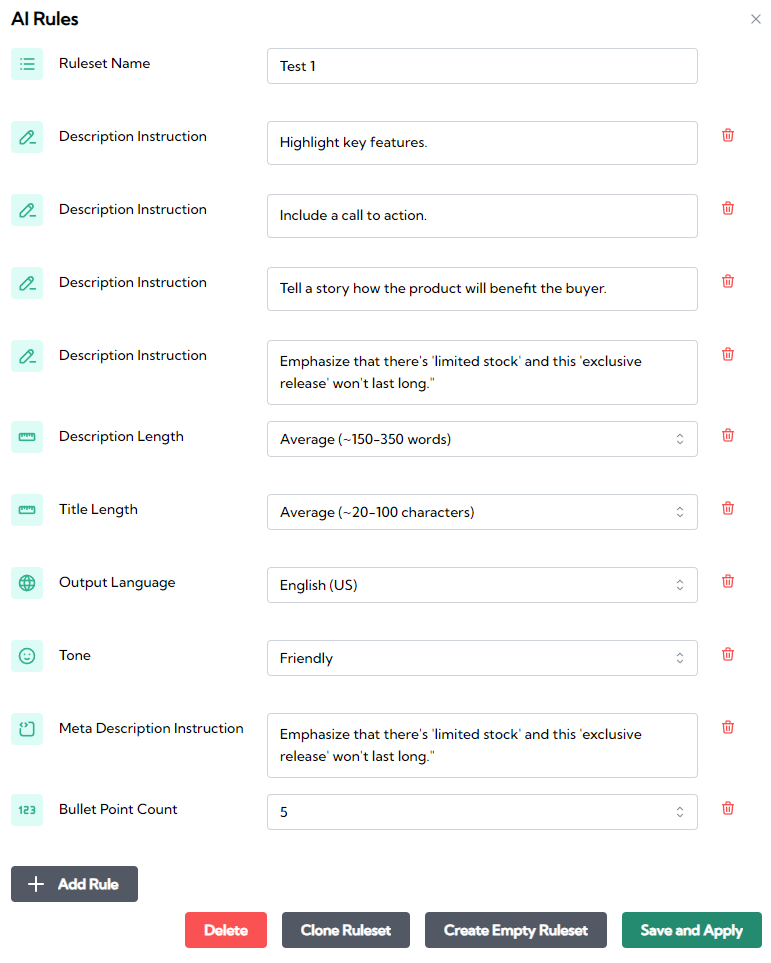
You could have a ruleset for each of the 11 ChatGPT prompts or four templates with different stacks, or all prompts in a single one. A lot of these prompts are already in the default ruleset, so you can use it right away without overthinking. Click here to get started for free on Describely.
Prompts for Writing Product Titles
ChatGPT is probably best for product titles out of the four categories.
That’s because this format has less room for error and relies more on iteration. ChatGPT excels at generating ideas, and there are only so many ways to write a title with specific keywords.
You can use the next 11 prompts designed for product titles. The difference with product titles is, it’s more manageable to review dozens of titles instead. That’s why we recommend you test as many of these as possible:
Prompt Title: Crafting Titles with Optimal Length
Prompt:
Create a title for our [specific product] that succinctly captures its essence, ensuring it remains within [ideal title length] characters for maximum engagement and readability.
Instructions:
To use this prompt, fill in the variables with the relevant information:
- [specific product]: Plug in the particular product you’re naming, such as ‘portable espresso maker’, ‘waterproof hiking boots’, or ‘organic lavender body lotion’.
- [ideal title length]: Define your target character count. Most platforms have their own best practices, but a range like “50-60” or “60-70” characters can be a good starting point.
For instance, when applied:
Create a title for our waterproof hiking boots that succinctly captures its essence, ensuring it remains within 60-70 characters for maximum engagement and readability.
By following this prompt, you’ll craft titles that are punchy and to the point, optimizing them for skimming, click-through rates, and platform requirements.
Prompt Title: Setting the Right Title Tone
Prompt:
Create a title for our [specific product] that embodies a [desired tone] vibe, making sure it aligns with our brand voice and speaks directly to our target audience.
Instructions:
To use this prompt, fill in the variables with the relevant information:
- [specific product]: Insert the particular product you’re naming, like ‘luxurious silk pajamas’, ‘rugged camping gear’, or ‘artisanal chocolate truffles’.
- [desired tone]: Specify the tone or emotion you want the title to convey, such as ‘elegant’, ‘adventurous’, or ‘indulgent’.
A sample in action might look like:
Conceive a title for our luxurious silk pajamas that embodies an ‘elegant’ vibe, making sure it aligns with our brand voice and speaks directly to our target audience.
Harnessing this prompt, you’ll be able to create titles that not only describe a product but also evoke the desired feelings and associations in your customers, making your products more enticing.
Prompt Title: Titles Optimized for Google & Amazon SEO
Prompt:
Generate a title for our [specific product] that incorporates [target keywords], ensuring it’s optimized for ranking on both Google and Amazon search platforms.
Instructions:
To use this prompt, fill in the variables with the relevant information:
- [specific product]: Input the particular item you’re naming, such as ‘ergonomic office chair’, ‘vegan leather tote bag’, or ‘multivitamin gummies’.
- [target keywords]: Identify the primary keywords or phrases related to your product that potential customers might use in their search. Be strategic in choosing keywords that are relevant and can boost visibility.
As an illustrative example:
Generate a title for our ergonomic office chair that incorporates ‘lumbar support and adjustable height’, ensuring it’s optimized for ranking on both Google and Amazon search platforms.
Utilizing this prompt helps you craft titles that are not only descriptive but also packed with SEO potential, increasing your product’s
visibility and potential for sales on major search platforms.
Prompt Title: Crafting Titles for Specific Languages
Prompt:
Devise a title for our [specific product] that resonates in both English and [desired language], ensuring that it’s clear, catchy, and culturally appropriate.
Instructions:
To use this prompt, fill in the variables with the relevant information:
- [specific product]: Insert the particular product you’re naming, e.g., ‘stainless steel watch’.
- [desired language]: Indicate the language you’re targeting, such as ‘French’, ‘Japanese’, or ‘Spanish’.
For instance:
Devise a title for our stainless steel watch that resonates in both English and French, ensuring it’s clear, catchy, and culturally appropriate.
By employing this prompt, you ensure your product titles appeal to broader audiences and are mindful of cultural nuances.
Prompt Title: Writing Titles that Spark Urgency
Prompt:
Produce a title for our [specific product] that conveys a sense of scarcity or time-sensitive urgency, compelling potential buyers to act swiftly. Use this: [Insert scarcity or urgency]
Instructions:
To use this prompt, fill in the variables with the relevant information:
- [specific product]: Enter the particular item you’re highlighting, e.g., ‘handmade leather wallet’.
- [Insert scarcity or urgency]: Examples include: limited time offer, only 5 remaining, available until a specific date.
Example:
Produce a title for our handmade leather wallet that conveys a sense of scarcity or time-sensitive urgency, compelling potential buyers to act swiftly. Use this: Only available through November.
Utilizing this prompt can drive immediate customer action by tapping into the FOMO (Fear of Missing Out) sentiment and highlighting the product’s exclusive nature.
Prompt Title: Incorporating Social Proof into Product Titles
Prompt:
Write a title for our [specific product] that subtly weaves in elements of social proof, such as high ratings, bestseller status, or user endorsements. Use this social proof [insert social proof].
Instructions:
To use this prompt, fill in the variables with the relevant information:
- [specific product]: Input the item you’re presenting, for instance, ‘noise-canceling headphones’.
- [insert social proof]: For example: number of reviews, ratings, endorsements, etc)
Example:
Write a title for our noise-canceling headphones that subtly weaves in elements of social validation, such as high ratings or user endorsements. Here’s social proof that you can use: Rated 4.7 from 500 reviews.
By leveraging this prompt, you’re integrating a seal of approval right into your product title, offering assurance to potential buyers and boosting credibility.
Prompt Title: Creating Titles Infused with Seasonal Charm
Prompt:
Craft a title for our [specific product] that captures the essence of [particular season], aligning the product with the season.
Instructions:
To use this prompt, fill in the variables with the relevant information:
- [specific product]: Mention the product you’re working with, e.g., ‘wool scarf’.
- [particular season]: Define the season you’re channeling, such as ‘winter’, ‘fall’, or ‘summer’.
Example:
Craft a title for our wool scarf that captures the essence of winter, aligning the product with the cozy, cold-weather vibes.
By utilizing this prompt, you’re making the product feel current and relevant, capitalizing on the mood and feelings associated with different times of the year.
Prompt Title: Titles that Spotlight Product Attributes & Key Features
Prompt:
Write a title for our [specific product] that highlights its standout features, making it evident what sets this product apart from others. Here are the key features to highlight: [insert features].
Instructions:
To use this prompt, fill in the variables with the relevant information:
- [specific product]: Specify the item you’re promoting, like ‘wireless earbuds’.
- [insert features]: Consider what the key features are, such as ‘noise-cancellation’, ’24-hour battery life’, or ‘seamless Bluetooth pairing’.
Example:
Design a title for our wireless earbuds that highlights its standout feature of noise-cancellation, making it evident what sets this product apart. Here are the key features to highlight: ‘noise-cancellation, water-proof, 24-hour battery life, seamless bluetooth pairing
By focusing on this prompt, you’re instantly informing the potential buyer about what makes your product unique or superior, reducing their search time and amplifying the product’s appeal.

Prompt Title: Titles with Clear Variant Details
Prompt:
Write a title for our [specific product] that seamlessly integrates its size or variant detail, providing clarity and ensuring the right fit for potential buyers. Here’s what you should highlight: [insert variant details].
Instructions:
To use this prompt, fill in the variables with the relevant information:
- [specific product]: Plug in the product you’re referring to, such as ‘running shoes’.
- [insert variant details]: Think about the size or variant specifics like ‘men’s’, ‘size 10’, ‘slim-fit’, or ’16GB’.
Example:
Write a title for our running shoes that seamlessly integrates its size detail, providing clarity and ensuring the right fit. Here’s what you should highlight: [size: men’s size 10].
When you use this prompt, you’re offering an extra layer of information right in the title, streamlining decision-making for customers and potentially reducing returns due to size or variant mismatches.
Prompt Title: Titles that Radiate Luxury & Premium Quality
Prompt:
Compose a title for our [specific product] that embodies luxury and premium quality, making potential customers feel the exclusivity and superior craftsmanship of the item.
Instructions:
To use this prompt, fill in the variables with the relevant information:
- [specific product]: Input the product in focus, for instance, ‘designer handbag’.
- Think about words or phrases that exude luxury such as ‘artisan’, ‘limited edition’, ‘handcrafted’, or ‘elite’.
Example:
Compose a title for our designer handbag that embodies luxury, using words like ‘artisan-crafted’ or ‘limited edition’, to convey its exclusivity and superior craftsmanship.
By leaning into this prompt, you’re setting a high-end tone for your product, appealing to a more discerning audience looking for the best of the best in their purchases.
Prompt Title: Combo-Packed Title Structures
Prompt:
Create a title for our [specific product] that combines [key elements], giving a more complete snapshot in just a few words.”
Instructions:
To use this prompt, fill in the variables with the relevant information:
- [specific product]: Enter the particular item you’re spotlighting, e.g., ‘smartwatch’.
- [key elements]: Identify two or more standout characteristics or features of your product that you want to weave into the title. For instance, ‘water-resistant’, ‘heart rate monitor’, or ‘sleek design’.
Example:
Create a title for our smartwatch that combines ‘water-resistant’ and ‘heart rate monitor’, giving potential customers a richer understanding from just the title.
Harnessing this prompt allows you to convey multiple aspects of your product concisely, giving potential customers a richer understanding from just the title.
That’s 11 ChatGPT prompts to help you find product title ideas.
Remember, you don’t need every prompt to generate the exact title you like. You’ll find the best one faster if you just try more of them.
If you’ve read this far and haven’t tried any prompts yet, here’s a second approach to consider: start with the title. Then, leverage it for your prompts to generate better product descriptions, meta descriptions, and tags.
Now, what if you need titles for 10+ similar products? If you put them all in one ChatGPT conversation, they may sound repetitive. If you put them separately, they may sound inconsistent.
But when you bulk-generate on Describely, you reach this balance for brand identity and uniqueness.
Prompts for Writing Meta Descriptions
Meta descriptions are a tricky part of product content. They’re longer than titles, shorter than product descriptions, and if you write them wrong they won’t show up in a Google search. Specifically, Google rewrites meta-descriptions 62.78% of the time according to this Ahrefs study.
If you don’t want to waste time on meta-descriptions that won’t even appear in a Google search, you need to limit how much time and effort you put into these and prioritize high-volume keywords. Ideally, you should also test different meta-descriptions to see which ones show up in a search.
Because even when they don’t, the 37.22% that shows up on Google will at least sound different from competitors and get better click-through rates (CTR).
What better way to do it than with ecommerce focused ChatGPT prompts?
The following six will help you capture the right tone, sense of urgency, and keyword-inclusive features within a tight character limit:
Prompt Title: Crafting Meta Descriptions of Optimal Length
Prompt:
Write a concise and impactful meta description for our [specific product] that stays within the optimal [character limit], ensuring it displays correctly on search engines and attracts potential buyers.
Instructions:
To use this prompt, fill in the variables with the relevant information:
- [specific product]: Input the product you’re promoting, for instance, ‘wireless earbuds’.
- [character limit]: Aim to keep your meta description between 50-160 characters for best results on most search engines.
Example:
Create a concise meta description for our wireless earbuds that highlights sound quality and comfort, all while staying under 160 characters.
Using this prompt ensures you create meta descriptions that are search-engine friendly and give users just enough enticing information to click through.
Prompt Title: Setting the Perfect Tone in Meta Descriptions
Prompt:
Draft a meta description for our [specific product] that adopts a [desired tone], aligning with our brand voice and appealing directly to our target audience.”
Instructions:
To use this prompt, fill in the variables with the relevant information:
- [specific product]: Mention the product you’re showcasing, such as ‘luxury handbag’.
- [desired tone]: Determine the emotional vibe you want to convey, like ‘elegant’, ‘playful’, ‘professional’, or ‘casual’.
Example:
Draft a meta description for our luxury handbag that adopts an ‘elegant’ tone, emphasizing its timeless design and craftsmanship.
By following this prompt, you ensure your meta descriptions not only inform but also emotionally resonate with potential customers, reinforcing your brand’s identity.

Prompt Title: SEO-Optimized Meta Descriptions
Prompt:
Write an SEO-optimized meta description for our [specific product] incorporating the keywords [target keywords], ensuring it ranks higher in search engine results.
Instructions:
To use this prompt, fill in the variables with the relevant information:
- [specific product]: Fill in with the product you’re focusing on, e.g., ‘organic skincare serum’.
- [target keywords]: List the primary keywords you aim to rank for, such as ‘anti-aging’, ‘natural ingredients’, or ‘hydrate’.
Example:
Write an SEO-optimized meta description for our organic skincare serum, incorporating keywords like ‘anti-aging’ and ‘natural ingredients’, to enhance its visibility on search engines.
With this prompt’s guidance, you’ll be crafting meta descriptions that not only appeal to potential customers but also cater to search engine algorithms for better visibility.
Prompt Title: Meta Descriptions that Convey Scarcity & Urgency
Prompt:
Write a meta description for our [specific product] that communicates scarcity and prompts urgency, encouraging potential buyers to act swiftly.
Instructions:
To use this prompt, fill in the variables with the relevant information:
- [specific product]: Specify the item you’re marketing, such as ‘limited-edition sneakers’.
- Integrate phrases or terms that indicate limited availability or time sensitivity, like ‘limited stock’, ‘few left’, ‘exclusive release’, or ‘offer ends soon’.
Example:
Write a meta description for our limited-edition sneakers emphasizing that there’s ‘limited stock’ and this ‘exclusive release’ won’t last long.”
By harnessing this prompt, your meta descriptions will create a compelling sense of immediacy, prompting quicker decision-making from potential buyers.
Prompt Title: Incorporating Social Proof in Meta Descriptions
Prompt:
Craft a meta description for our [specific product] that weaves in elements of social proof, instilling confidence in potential buyers about the product’s credibility and popularity.
Instructions:
To use this prompt, fill in the variables with the relevant information:
- [specific product]: Input the item you’re highlighting, for instance, ‘best selling fitness tracker’.
- Introduce social proof components like ‘top-rated’, ‘customer favorite’, ‘award-winning’, or actual user testimonials if they’re succinct enough.
Example:
Craft a meta description for our best selling fitness tracker, showcasing it as a ‘top-rated’ device with ‘over 5,000 positive reviews’.”
Utilizing this prompt ensures that your meta descriptions leverage the power of community endorsement, nudging prospects closer to making a purchase.
Prompt Title: Highlighting Key Features in Meta Descriptions
Prompt:
Compose a meta description for our [specific product] emphasizing its standout features, ensuring potential customers immediately understand its unique value propositions.
Instructions:
To use this prompt, fill in the variables with the relevant information:
- [specific product]: Name the product you’re detailing, like ‘4K OLED television’.
- Pinpoint the most compelling features or USPs of your product that you want to highlight.
Example:
Compose a meta description for our 4K OLED television, underscoring features like ‘ultra-high definition’, ‘smart connectivity’, and ‘sleek bezel-less design’.
By following this prompt, you make sure your meta descriptions quickly communicate the distinctive features that set your product apart, offering clarity to potential buyers.
As with product titles, you can’t go wrong with any of these six prompts as long as you compare some variants first. Combining these should work well because of the character limit. But if you had to pick just one, the “SEO-optimized meta description” seems the least likely to be replaced by Google.
With that said, product meta descriptions will not make or break your marketing strategy. You don’t want to spend too much time on these when you could work on other products instead. Whether you manage dozens or hundreds, it’s easier to automate with the Describely meta-description generator:
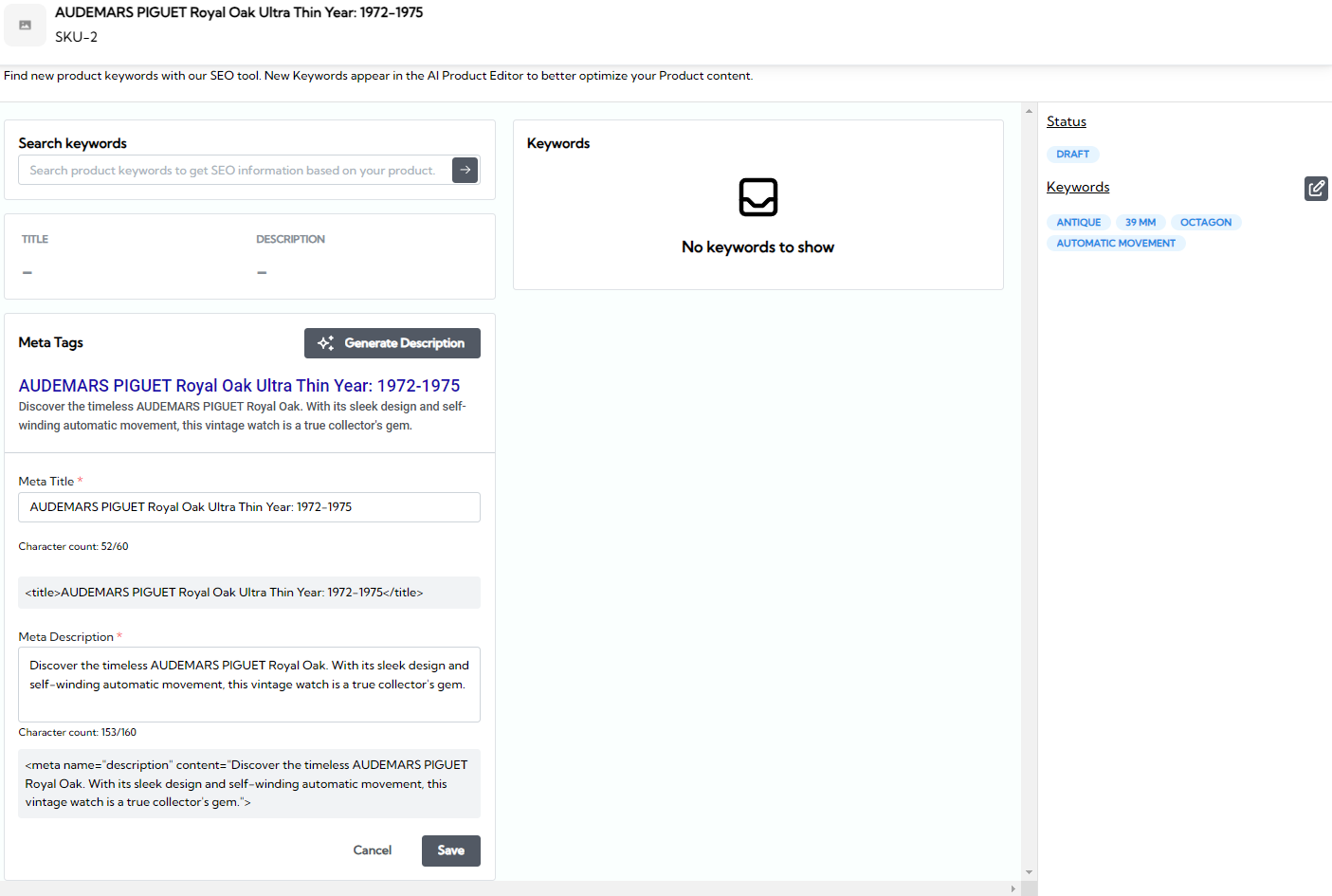
After you add a product, simply go to SEO tools, add a meta-title, and click Generate Description. You can edit if something is missing or click Generate again. The best part: it supports multiple platforms and custom rulesets.
Prompts for Generating Tags
The remaining four prompts will help you identify the right product tags with almost no effort. Not only can this influence your organic rankings but also gets you a slight edge for conversions. Visitors are more likely to become buyers if they can find their product faster, especially as you add more listings.
Prompt Title: Extracting Product Tags from Descriptions
Prompt:
“Generate a list of tags based on this product description: ‘[product description]’.”
Instructions:
To use this prompt, fill in the variables with the relevant information:
- [product description]: Insert the complete description of your product here.
Example:
Generate a list of tags based on this product description: ‘A slim-fit, blue denim jacket with a vintage wash… (add entire product description).’
Expected Output: slim-fit, blue, denim, jacket, vintage wash.
Using this prompt facilitates the extraction of pertinent keywords or tags from a given product description. This ensures you categorize your product effectively on your e-commerce platform, enhancing discoverability.
Prompt Title: Competitor-Informed Tag Generation
Prompt:
Considering competitors label similar products as ‘[competitor description]’, generate distinguishing tags for our product described as ‘[our product description]’.
Instructions:
To use this prompt, fill in the variables with the relevant information:
- [competitor description]: Insert the description or tags competitors commonly use for similar products.
- [our product description]: Input your product’s unique description here.
Example:
Considering competitors label similar products as ‘sustainable and eco-friendly’, generate distinguishing tags for our product described as ‘Made from 100% recycled materials with a carbon-neutral manufacturing process.
Expected Output: 100% recycled, carbon-neutral, sustainable manufacturing.
By leveraging this prompt, you’re guiding the AI to emphasize the unique attributes of your product in comparison to what’s commonly highlighted by competitors, ensuring you stand out in the market.
Prompt Title: Sentiment-Informed Product Tag Generation
Prompt:
Based on user sentiments like ‘[user feedback]’, generate appropriate product tags.
Instructions:
To use this prompt, fill in the variables with the relevant information:
- [user feedback]: Insert collective sentiments or specific user reviews about the product.
Example:
Based on user sentiments like ‘cozy, warm, and perfect for winter’, generate appropriate product tags.
Expected Output: cozy, warm, winter-perfect.
With this prompt, you’re transforming user sentiments and reviews directly into actionable tags, ensuring your product resonates with the feelings and perceptions of your customers.
Prompt Title: Generating Tags That Signal Purchase Intent
Prompt:
Based on the product description for our [type of product], generate a set of tags that would indicate a strong likelihood of purchase intent.
Instructions:
To use this prompt, fill in the variables with the relevant information:
- [type of product]: Identify what you’re selling. This could be anything from a kitchen appliance to jewelry.
Example:
An example of a complete prompt could be: “Based on the product description for our smart thermostat, generate a set of tags that would indicate a strong likelihood of purchase intent.”
Example Output:
Energy-efficient, Smart Home Compatible, Easy Installation, Cost-saving, 24/7 Control, Mobile App
These tags are designed to align with what a ready-to-buy consumer is looking for in a smart thermostat. They aren’t just descriptive; they also align with common purchase drivers like efficiency, cost savings, and ease of use. By targeting these features as tags, you’re more likely to attract clicks from shoppers who are in the final stages of the buying process.
Those are all prompts for product tags. If you just want a one-minute fix, use the first prompt and paste the description you generated before. If you want to go the extra mile, no.4 will help your sales the most.
Either way, all products already have tags when you generate descriptions with Describely.
ChatGPT vs Ecommerce-Focused AI Tools
We hope you’ve found value in these hand-crafted ChatGPT prompts! While ChatGPT is a stellar tool for individual tasks, there are much better options to overcome its limitations, especially for the unique demands of ecommerce.
Simply put, a lot more work goes into crafting product descriptions with ChatGPT than with a specialized AI platform like Describely. You now have the 30+ best prompts, but your work doesn’t end here:
- As mentioned before ChatGPT tends to sound either monotonous or inconsistent. You’ll have to review the catalog and see if it sounds right as a whole. It’s less work with the Describely AI model (exclusively designed for online stores).
- ChatGPT has barely any organization. No edits, no sorting, no catalogs. The best answers are often buried in five-page conversations. On Describely, it’s a dashboard with all your catalogs, each with different products, with their own descriptions, SEO settings, and independent chat history, which you can edit and save.
- ChatGPT has limited SEO tools. While it can fetch keywords, it doesn’t show which ones are missing or not frequent enough. ChatGPT tends to agree with whatever you wrote before. Describely calculates SEO scores from your main keyword and shows related keywords that you didn’t include.
- ChatGPT adds complexity to product management. After you find the generated descriptions, you have to constantly switch platforms to update your listings. When you have many products, it’s too easy to make mistakes like adding the wrong description to similar products. Instead, Describely has PIM integrations and plugs into your online store to show changes immediately.
- And if you forgot to add something, ChatGPT can’t update all conversations at once from one prompt. But Describely can update your entire catalog with a highly customizable ruleset. Keep titles unchanged? Update all but the latest two products? Replace keywords? It’s all possible without opening a single product page.
In short, ChatGPT is not designed for ecommerce. The previous points aren’t flaws, but rather unintended features for an AI assistant. If you’re looking for an ecommerce-specific tool to save time managing your product content process, look no further than Describely.
Why You Don’t Need 30+ Complex Prompts With Describely
When you write with Describely you won’t need as many prompts to find the ideal product description.
The ChatGPT prompts are designed to narrow the generic, broad conversations down to the ecommerce format. Describely is exclusively about product content, from the AI model to the latest feature.
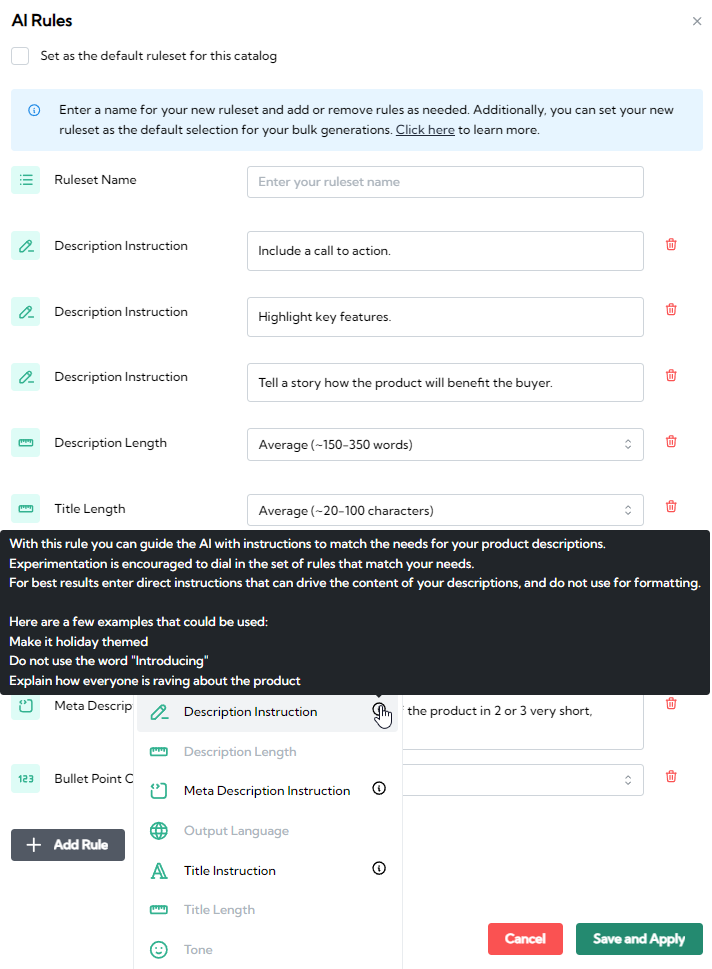
The 32 ChatGPT prompts can be simplified to a single ruleset. Describely is already optimized for product descriptions (although customizable) so you won’t have to worry about the format. Instead, you can focus on your brand voice, the features, and the benefits that will turn your visitors into customers.
Want to try Describely for yourself? Sign up for a free trial here.

FAQ
To make the most out of these prompts here’s a quick Q&A:
TL;DR. What’s the best prompt for ecommerce product descriptions?
Although oversimplified, the best prompts are the fifth and last three from the first section (the ones related to storytelling and the right tone for your industry). Everything else is easy to edit or refine later, but those are the ones that make your descriptions stand out.
Click here to grab your PDF version of the 30 ChatGPT Prompts for Better Product Content.
Do these ChatGPT prompts work with custom instructions?
Yes. As long as you don’t use custom instructions to change the format, the result should be the same. Our 30+ prompts were designed not to need any custom rules. If you want to use them, limit your instructions to brand voice prompts for better results.
Can ChatGPT bypass the ecommerce limitations with the latest premium version?
The ecommerce limitations of ChatGPT don’t have much to do with its intelligence, but rather its design. ChatGPT can do A LOT besides product content, which generally means you spend most of your time telling it what not to say rather than what you want.
It’s like building a website coding on C++ instead of a specialized language (HTML) or a web-design platform.
Is ChatGPT worth paying for ecommerce product copy?
Short answer: No. You’re not really buying an ecommerce product description generator, whereas with Describely, you get all the features and rules optimized for your store. Bulk generation, PIM integrations, effortless editing…
Features aside, with ChatGPT premium you still have to tweak rules and test prompts to get great product descriptions. Describely has these optimized by default.
How else can I save time writing ecommerce product copy?
If you truly want to save time on product content, it’s worth looking beyond ChatGPT. In our eCommerce AI platform, for example:
- You don’t have to keep track of every answer, useful or not. Describely organizes descriptions in products and catalogs, which you can edit directly.
- You won’t need as many prompts as in ChatGPT, because Describely has AI rules optimized for ecommerce by default.
- You won’t need ten tabs open to move around descriptions. It’s one platform to generate, edit, import, export, and upload.
- You can generate all descriptions in bulk so they’re consistent yet original.
Next steps: get started with Describely and start with these ChatGPT prompts to see the difference yourself.
And if you’re struggling to get ChatGPT to work well for your eCommerce product descriptions? Check out how it compares to Describely in this post.
